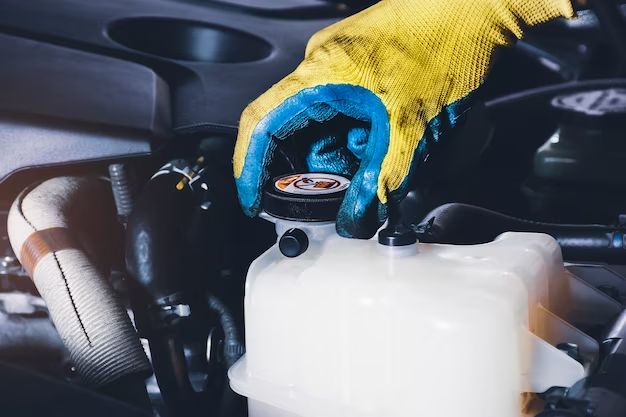The coolant reservoir, also known as the overflow tank or coolant expansion tank, is an important part of your vehicle’s cooling system. It holds extra coolant to allow for the expansion and contraction of coolant that occurs as the engine heats up and cools down. Over time, the coolant reservoir can become damaged or corroded and may need to be replaced. So when should you replace your coolant reservoir? There are a few signs to watch out for that indicate it’s time for a new coolant reservoir.
Page Contents
Signs That Your Coolant Reservoir Needs Replacement
Here are some of the main signs that your coolant reservoir needs to be replaced:
Cracks or Damage
Check your coolant reservoir regularly for any cracks, holes, or other exterior damage. Things like impacts, debris, and general wear and tear can cause the reservoir to become compromised over time. Any cracks or damage means it’s time to replace the reservoir before a more significant leak or failure occurs.
Corrosion and Rust
The coolant reservoir is made of plastic, which can become brittle and corroded from exposure to hot coolant and road elements. Look inside the reservoir for signs of rust, scale build-up, pitting, and corroded seams. Significant corrosion indicates the tank has weakened and needs replacing.
Low Coolant Levels
If you are having to frequently top up the coolant level, even when there are no visible leaks, the reservoir may be cracked and seeping. The plastic can develop micro-fissures over time that allow coolant to slowly seep out without an obvious puddle under the vehicle.
Cloudy or Contaminated Coolant
The coolant reservoir allows you to inspect the appearance of the coolant itself. If it has become cloudy, contaminated with debris or oil, or has changed color, the entire cooling system needs flushing. Go ahead and replace the reservoir when you flush the system.
Age
The plastic material of coolant reservoirs gradually degrades over time. Even if there are no cracks or corrosion, it’s a good idea to replace the reservoir every 5-6 years or 60,000 miles as general maintenance. Old plastic becomes more brittle and prone to cracking.
When to Replace Based on Vehicle Age and Mileage
As a general guideline, you should plan on replacing your coolant reservoir at these intervals as part of your regular maintenance:
| Vehicle Age | Mileage |
|---|---|
| 5-6 years | 60,000 miles |
| 7-8 years | 90,000 miles |
| 9-10 years | 120,000 miles |
| 10+ years | 150,000+ miles |
Of course, inspect for cracks and corrosion regularly and replace as soon as any signs of damage are spotted. But these age and mileage intervals are a good rule of thumb for replacing the reservoir as part of your ongoing maintenance schedule.
Replacing the Coolant Reservoir
Replacing the coolant reservoir is usually a straightforward DIY job on most vehicles. Here are the basic steps:
Materials Needed
- New coolant reservoir for your vehicle
- Coolant (mixture of 50/50 antifreeze and distilled water)
- Funnel
- Rags, drip pan, gloves
Steps
- Allow vehicle engine to fully cool before starting the job
- Relieve any pressure in the cooling system by slowly opening the radiator cap
- Disconnect the hoses from the old coolant reservoir and drain it into a drip pan
- Remove any fasteners or brackets securing the old reservoir
- Thoroughly clean the area around where the reservoir mounts
- Install the new reservoir with fasteners/brackets and connect the hoses
- Refill the reservoir with coolant to the proper level
- Top off radiator and overflow tank with fresh coolant
- Run engine and inspect for leaks
- Dispose of old coolant properly
Always refer to your vehicle repair manual for the proper procedures. Let the vehicle run to operating temperature to fully bleed any air from the cooling system after refilling.
Signs of Issues After Replacing Coolant Reservoir
After replacing your coolant reservoir, watch for these signs of potential problems:
- Visible leaks around the new reservoir
- Low coolant warning light comes on
- Engine overheats
- Coolant requiring frequent topping off
- Milky oil indicating coolant and oil mixing
Any of these could indicate an improper installation or underlying problem with the hoses or other components in the cooling system. Have your mechanic inspect the system if you notice these warning signs after a reservoir replacement.
Preventing Damage and Failure
You can help prevent premature failure of your coolant reservoir and extend its life by following these tips:
- Regularly inspect reservoir for cracks and corrosion
- Replace at recommended intervals based on age/mileage
- Use recommended coolant mix
- Flush entire system yearly to remove contaminants
- Ensure coolant overflow hose is not kinked or blocked
- Top up coolant level to max line when engine is cold
- Avoid knocking or damaging reservoir when working in engine bay
Proper maintenance and care will help your coolant reservoir last to its intended lifespan. But reservoirs are wear items, and will eventually need replacement, so inspect regularly.
Conclusion
The coolant reservoir is an important part of your vehicle’s cooling system. Keep an eye out for cracks, leaks, corrosion, and other damage or deterioration. Plan on replacing the reservoir every 5-6 years or 60,000 miles on average. More frequently with an older high-mileage vehicle. Use the signs and guideline in this article to identify when it’s time to replace your coolant reservoir. Proper maintenance and care will help maximize its lifespan. But reservoirs are wear items that will need replacement as part of your vehicle’s ongoing maintenance.
